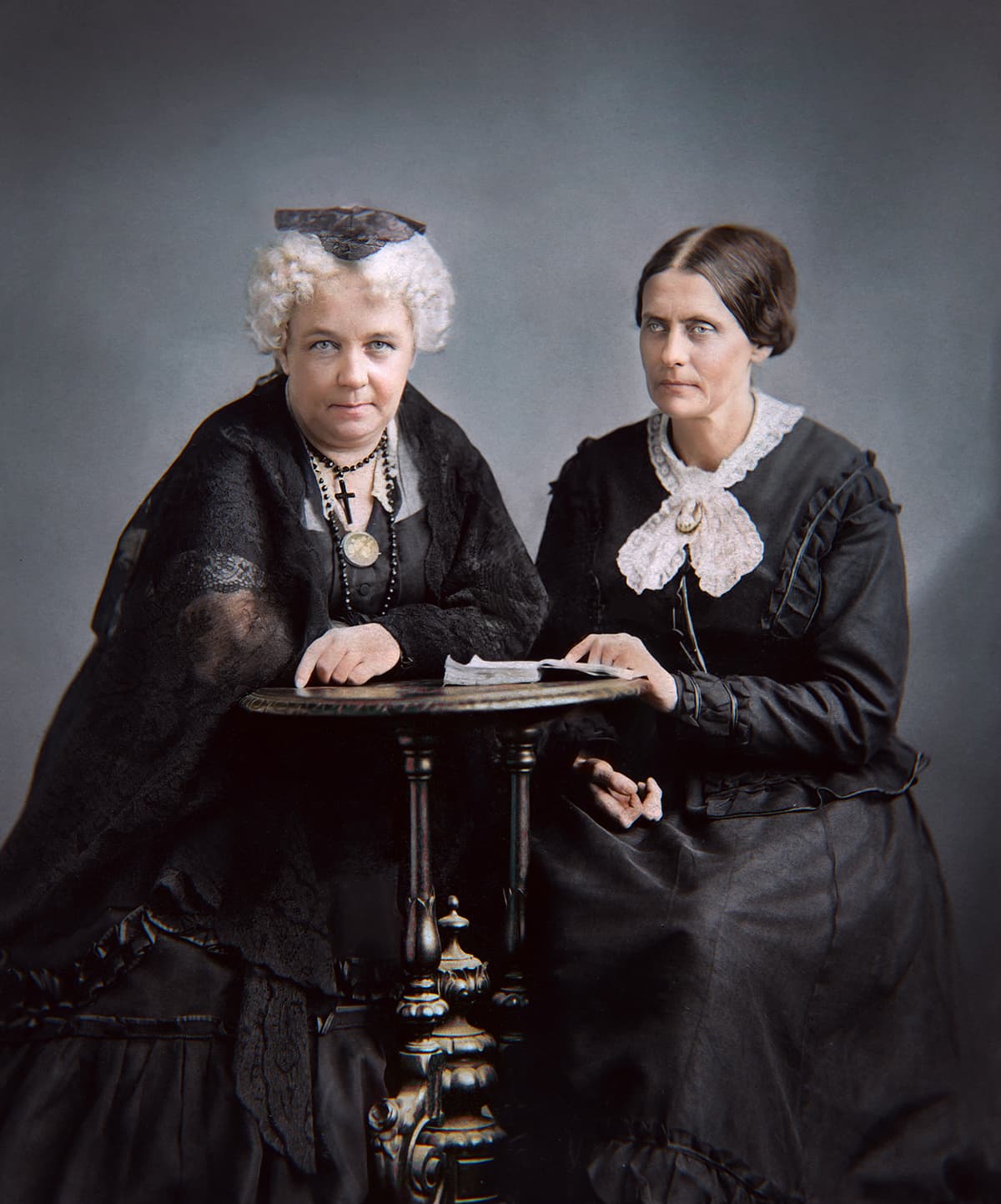The chain of events began simply. It was inevitable that the young leader of Rochester’s Daughters of Temperance, Susan B. Anthony, would meet the woman in nearby Seneca Falls who, at age 29, had started her own newspaper to promote temperance. Now in its fourth year of publication, The Lily had from the first served another purpose, declaring “It is WOMAN that speaks through the LILY.”1 Its masthead carried the heading “Devoted to the Interests of Women.”2 In the words of its proprietor, Emilia Bloomer, hers was the first temperance paper aimed at an exclusively female audience that was “owned, edited and published by a woman.”3 Susan Anthony was a subscriber.4
The two women had much in common: both were former teachers,5 and they were nearly the same age. They shared a firm commitment to the temperance cause, and an uncommon willingness to defy conventional assumptions about women’s roles. Just as importantly, both women were passionate about ending slavery. Susan’s temperance work filled her days but did not keep her away from antislavery conferences. After meeting Frederick Douglass’s friend Abby Kelley at one such conference, she even joined Kelley and her abolitionist husband Stephen Foster on the road for a weeklong antislavery speaking tour.6
It was their shared interest in abolition that led Emilia Bloomer to invite Susan Anthony to an antislavery meeting in Seneca Falls in May 1851, where William Lloyd Garrison and the British abolitionist George Thompson would be the featured speakers.
For the occasion, Emilia wore what was increasingly becoming her standard outfit: Turkish-style pantaloons under a skirt that reached only halfway down her legs. As an alternative to the cumbersome full-length skirts that women traditionally wore, it was more practical, though hardly stylish. “Bloomer” had already become a metonym for the garb as a result of Emilia’s constantly promoting it in her journal. (But she had not invented it. The costume was the creation of Elizabeth Smith Miller, daughter of Gerrit Smith—former Liberty League presidential candidate, and Elizabeth Cady Stanton’s cousin.)
Seneca Falls was also the Stanton family’s home. The featured speakers at the day’s event, George Thompson and William Lloyd Garrison, were the houseguests of Elizabeth Cady Stanton and her husband, Henry Stanton.7 Anthony knew Garrison from his occasional Sunday visits to her family’s farm, and so looked forward to possibly having a word with him after the event. Even more, she hoped for an introduction to Elizabeth Cady Stanton. Ever since receiving her family’s glowing reports of Stanton’s performance at the 1848 Woman’s Rights Convention in Rochester, which Anthony did not attend, she had wanted to meet this dynamic woman.8
Inside the hall, Garrison set his abolitionist audience on fire, railing against the Fugitive Slave Act. It was his persistent theme; the hated law dominated discussion at the American Antislavery Conference in Syracuse at which he and Thompson, along with Gerrit Smith, had spoken a few days earlier. The law’s potency as a rallying cause for the abolition movement was apparent from the fact that all five issues of Garrison’s The Liberator that month denounced the Fugitive Slave Act on page one.9
Ever since receiving her family’s glowing reports of Stanton’s performance at the 1848 Woman’s Rights Convention in Rochester, which Anthony did not attend, she had wanted to meet this dynamic woman.
Undoubtedly Emilia Bloomer and Susan Anthony were energized by the evening’s presentations. There was much to talk about with these men, if only the opportunity might arise. It soon did. Outside the hall, Emilia Bloomer stood on the street corner with her guest Susan Anthony, waiting for Elizabeth Stanton and the two speakers to pass by on their way to dinner at the Stanton residence. When the threesome appeared, brief formal exchanges followed.
Bloomer was already well acquainted with Stanton, who had been writing for The Lily over the last few years. So she took the initiative in introducing Stanton to Anthony. Despite the brevity of the introduction, Stanton was immediately impressed—so much so that the details stayed with her for a lifetime. “There she stood,” Stanton recollected of Anthony a half century later, “with her good, earnest face and genial smile, dressed in gray delaine, hat and all the same color, relieved with pale blue ribbons, the perfection of neatness and sobriety. I liked her thoroughly.”10
Even so, Anthony’s hopes of an impromptu dinner invitation fizzled. The two celebrity abolitionists and their host went on their way. But the introduction having been made, in days following Anthony visited the Stanton home, where she was warmly received.11 The two women immediately launched into conversation about temperance, abolition, and women’s rights.
Stanton was thrilled to have another independent-minded woman with whom she could collaborate. Notwithstanding the attention she had been able to attract to Seneca Falls through the 1848 Woman’s Rights Convention and the impressive speakers who occasionally visited for antislavery meetings, her little town was still a byway on the Erie Canal—nothing like the exhilarating intellectual atmosphere she had so enjoyed during her years in Boston, the center of the abolitionist movement.
Anthony’s appearance on the scene was a godsend, and in more ways than one. She could come and go as she pleased, unlike Stanton, who was routinely pinned down at home caring for her three young boys. The new visitor soon became “Aunt Susan” to the Stanton children, occasionally looking after them and giving Stanton precious time to read and write.
For her part, Anthony learned from Stanton the inside story of the 1848 Woman’s Rights Convention, and the details of women’s exclusion from the 1840 World Antislavery Conference in London, where Stanton had met the Philadelphia abolitionist Lucretia Mott. She also heard about the work that Stanton and others had done in New York to establish married women’s property rights.
Anthony’s appearance on the scene was a godsend, and in more ways than one. The new visitor soon became “Aunt Susan” to the Stanton children, occasionally looking after them and giving Stanton precious time to read and write.
Almost immediately, Stanton began introducing Anthony to important leaders in the antislavery and women’s rights movements, beginning that very summer with Horace Greeley, editor of the New York Tribune, and Lucy Stone, a renowned speaker on both abolition and women’s rights. Within a year, Anthony was actively involved in the Third National Woman’s Rights Convention in Syracuse, where she was elected Secretary and established many more important relationships—in particular with Lucy Stone, who would become a close friend throughout the 1850s and encourage Anthony’s focus on women’s suffrage.
By 1853, Anthony was champing at the suffrage bit so hard that Stone had to hold her back. “Suffrage is sure to come to women,” Stone told her; “God will wait for it, and so may you.”12 But no relationship would match the working friendship that Susan Anthony and Elizabeth Cady Stanton began in 1851, which would last the rest of their lives.13
— Christopher Cox
Footnotes
- Amelia Bloomer and Anna C. Mattison, “To the Fairness of the Lily,” The Lily, January 1, 1848, 1. ↩︎
- Eleanor Flexner, Century of Struggle: The Woman’s Rights Movement in the United States (Cambridge: Belknap Press of Harvard University Press, 1975), 82. ↩︎
- Dexter C. Bloomer, Life and Writings of Amelia Bloomer (Boston: Arena Publishing Co., 1895), 45. Ownership aside, The Lily was not the first newspaper focused on issues of concern to women and edited by a woman. From 1828 Frances Wright edited the Free Enquirer in New York. and other newspapers edited by and for women circulated in New York and New England during the late 1830s. The Lowell Offering, written by women textile workers, was first published in 1840, and Lydia Maria Child edited the National Anti-Slavery Standard between 1841 and 1846. Tracy Lucht, “Amelia Bloomer, The Lily, and Early Feminist Discourse in the US,” American Journalism, vol. 38, no. 4 (November 2021), 391-415, at 392. ↩︎
- Dexter C. Bloomer, Life and Writings of Amelia Bloomer, 44. ↩︎
- Geraldine J. Clifford, Those Good Gertrudes: A Social History of Women Teachers in America (Baltimore: Johns Hopkins University Press, 2014), 23. ↩︎
- Alma Lutz, Susan B. Anthony: Biography of a Rebel, Crusader, and Humanitarian of the Women’s Rights and Feminist Movements (Boston: Beacon Press, 1959), 25. ↩︎
- Katharine Anthony, Susan B. Anthony: Her Personal History and Her Era (New York: Doubleday & Co., 1954), 117. ↩︎
- Lutz, Susan B. Anthony, 25-26. ↩︎
- The Liberator, vol. 21, no. 18 (May 2, 1851), 1; no. 19 (May 9, 1851), 1; no. 20 (May 16, 1851), 1; no. 21 (May 23, 1851), 1; no. 22 (May 30, 1851), 1. ↩︎
- Elizabeth Cady Stanton, Eighty Years and More (New York: European Publishing Co., 1898), 163. ↩︎
- Lutz, Susan B. Anthony, 26. ↩︎
- Sally G. McMillen, Lucy Stone: An Unapologetic Life (New York: Oxford University Press), 109. ↩︎
- Katharine Anthony, Susan B. Anthony, 118; Lutz, Susan B. Anthony, 26. ↩︎



